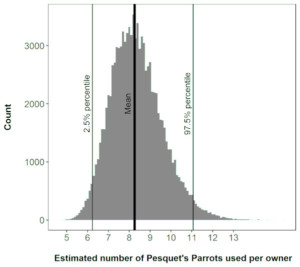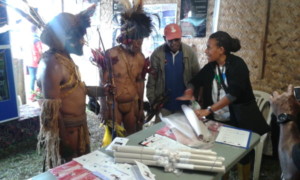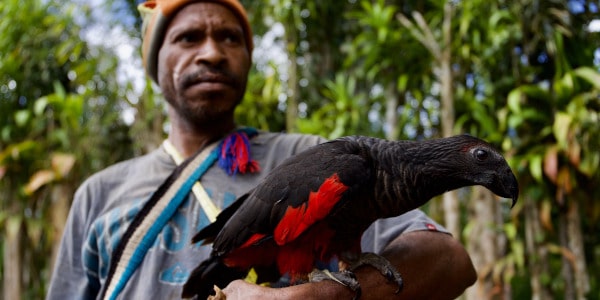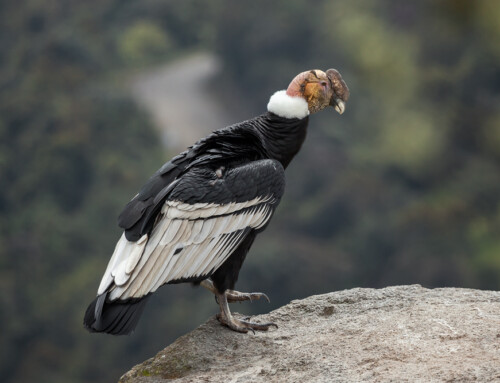LINKED PAPER
More dead than alive: harvest for ceremonial headdresses threatens Pesquet’s Parrot in Papua New Guinea. Nugi, G. & Whitmore, N. 2019. Emu – Austral Ornithology. DOI: 10.1080/01584197.2019.1676162. VIEW
In Papua New Guinea (PNG), a land renown for the beauty of its birds, people retain a close relationship with nature ― particularly with birds. In the highland province of Chimbu, the feathers of birds continue to be used in extravagant ceremonial headdresses. The headdresses from Chimbu province are especially renowned for their extravagant use of feathers. In these provinces the belly and underwing feathers of Pesquet’s Parrot (Psittrichas fulgidus), with their vibrant red vanes typically make up the headbands of the headdresses. Given the threatened status of Pesquet’s Parrot (IUCN Red List: Vulnerable) and its extensive use in headdresses we decided to quantify its cultural use in Kerowagi District, Chimbu Province, as an initial step to understand the magnitude of the harvest and its impact on the wild population.
We surveyed 170 people in Mingende, Kerowagi District, a locality well known for their use of Pesquet’s Parrot feathers (Fig. 1). Of the survey respondents, 43% had headdresses containing Pesquet’s Parrot feathers, owning an average of 2.9 headdresses (± 2.4 SD, N = 69) with each containing 2.9 (± 1.9 SD, N = 35) Pesquet’s Parrots. We estimated that an average of 8.4 Pesquet’s Parrots are contained within each owner’s headdresses (Fig. 2). Extrapolating for the adult population of Kerowagi District, via a bootstrap methodology, we revealed between 160,000 ‒ 280,000 Pesquet’s Parrots were likely harvested for the headdresses present in Kerowagi District alone. Although these headdresses are treated as heirlooms our data suggests that around ~8% of the Pesquet’s Parrot population would get harvested every year from Kerowagi District alone. Consequently, the number of dead Pesquet parrot present in the headdresses in Kerowagi dwarfs the best estimates of the total Pesquet’s Parrot population (21,000 pairs).




As Pesquet’s Parrots are used widely in headdresses throughout the highland provinces the total annual harvest is likely to be unsustainable if the wild population estimate is accurate. Since the extant Pesquet’s Parrot population is widely dispersed and highly mobile across areas of inaccessible foothill forest, we surmise that site-based conservation management is not likely to be viable. We conclude that the most practical conservation intervention is to reduce hunting by prolonging the lifespan of the existing headdresses already in existence. Indeed, a recent initiative from the Wildlife Conservation Society has employed a protection kit (comprised of naphthalene moth balls, paper and heavy duty plastic sheets, and instructions in Tok Pisin) to improve the preservation of headdresses through enhanced protection against mould, mouse, and insect damage (Fig. 3). The rationale behind such an initiative is that it is in the interest of the owner to avoid the cost of replacement feathers, and maintain the overall condition of their headdresses. The conservation return is that any extension of the lifespan of the headdress should result in a lower demand for replacement parts and therefore lower hunting pressure. While such a solution is low cost, to be effective the kits will have to used extensively across some key districts in the highlands. The challenge will be to find funding for organizations to deliver these kits at the necessary scale. In a donor environment driven by novelty, technology, and headlines simple, unglamorous solutions like the one developed by the Wildlife Conservation Society can easily be overlooked.


Nominate this article for a BOU Science Communication Award.
References
Igag, P., Mack, A.L., Legge, S., & Heinsohn, R. 2019. Breeding biology of three large, sympatric rainforest parrots in New Guinea: Palm Cockatoo, Pesquet’s Parrot and Eclectus Parrot. Emu 119: 196–204. VIEW
Mack, A.L. & Wright, D.D. 1998. The Vulturine Parrot, Psittrichas fulgidus, a threatened New Guinea endemic: Notes on its biology and conservation. Bird Conservation International 8: 185–194. VIEW
Swadling, P. 1996. Plumes from Paradise: Trade Cycles in Outer Southeast Asia and Their Impact on New Guinea and Nearby Islands until 1920. Papua New Guinea National Museum in association with Robert Brown and Associates: Boroko.
Image credit
Featured image: Street seller with Pesquet’s Parrot (Psittrichas fulgidus), Karamui, Chimbu Province © Elodie Van Lierde




